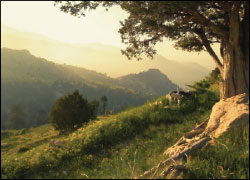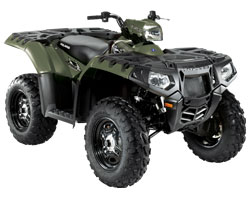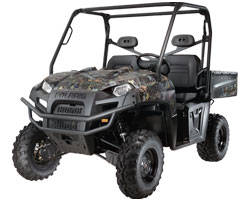Mapping Your Whitetail Hunting Paradise
Most serious deer hunters—a label that surely applies to QDMA members—realize in a hurry that managing whitetail habitat is just as fun as deer hunting itself. And Polaris® owners already know that their ATV or Side X Side is an important perfect tool for accomplishing that goal. Properly managed hunting spots not only result in better deer habitat, but better deer and better opportunities to hunt them. Here’s how to get started.

First, get a topo map or aerial photo of your property. This bird’s-eye view will help you see the big picture of your hunting property and help you learn how topography features will influence deer movement. It will also reveal some of the best sites for food plots, mineral licks and stand sites. But don’t make the mistake of only studying this map on your kitchen table. Hop in your Ranger 800 XP®, ride to the highest point on your property, and compare what is on paper to what you actually see. Maps can tell only rough detail; to recognize subtleties—a thin ditch, a small rise, recent habitat changes—you need to lay eyes on it. The new cab design adds more leg room, tilt steering and repositioned pedals--all of which helps make this type of scouting more enjoyable. In addition, an all-new seat with truck-like performance gives you a top-notch ride.
Fine-tuning a hunting property can take years, but start with four basic goals. First, identify difficult-to-hunt areas such as steep hillsides or ravines where swirling winds will help bucks catch your scent. Designate these areas as sanctuaries that you don’t invade during hunting season. Bucks will bed in them and feel safe when they venture out to food plots or to look for does. Circle several potential areas on your map, as they are the building block for your property management plan.

Second, plan for some food plots. Larger “destination” plots will contain the most feed and are meant to keep deer fed throughout the year. You can locate these in any large openings—existing or abandoned farm fields and old pastures are perfect—that you see on your map. Third, you can create smaller “hunting” plots in smaller natural openings or log landings, or simply by using a chainsaw. Hunting plots are a dual-purpose tool; they’re certainly meant to feed deer, but they’re also a perfect place to set up stands or blinds for hunting. Circle all of these areas on your map.
Your last step is to study the ground that lies between your sanctuaries and both types of food plots. What you’re seeking are potential ambush sites—places where you’ll hang a stand or erect a blind for the hunting season. The best of these will be situated along natural terrain features--a saddle in a ridge, a creek/ditch crossing, or a long brushy swale—that will funnel deer as they move between bedding areas and food sources. Here again, your maps and photos will get you started, but explore more thoroughly, on your Polaris ATV or Side X Side or on foot, to confirm the best spots. Next month, we’ll examine specific ways to implement the plans you’ve made!
ADVERTISEMENT
Related Vehicles
The Polaris Sportsman® 850 XP
Sportsman XP Facts:
- 850 SOHC Twin EFI Engine
- Available Electronic Power Steering
- Legendary Smooth Rolled Independent Rear Suspension (IRS)
- Superior Ergonomics
Learn More about the Sportsman XP >>
The Polaris RANGER 800 XP®
Ranger 800 XP Facts:
- New! 800 Twin EFI Engine
- Available Electric Power Steering
- Dual A-Arm Front Suspension
- Legendary Smooth Independent Rear Suspension (IRS)
Deer Management Archive
2009 Archive
- How to Judge a Trophy Buck's Potential
- Kick-Starting Your Management Plan
- Mapping Your Whitetail Hunting Paradise
- Conduct a Herd Monitoring Profile
2008 Archive
Deer Population by State
Weekly QDM Tips
Take a camera survey of your herd in the pre-season. Mount trail cameras near high-traffic deer areas such as mineral licks, food plots, or fence crossings. Record the number, sex and approximate age of every deer you “shoot”, then compare that data with your field observations come hunting season.







